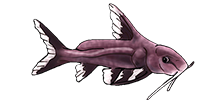Cory Deaths and Strange Behaviour
-
horsehunter
- Posts: 2
- Joined: 18 Apr 2003, 21:43
- Location 1: Ontario Canada
- Interests: Musky Fishing & Fish Tanks
Cory Deaths and Strange Behaviour
A while back I lost two albino corys about 6 weeks apart. Before death the fish hung at the top of the tank in a vertical position for a week to 10 days. these two fish were about 4 years old and in a planted 35 gallon tank with a number of tropicals mainly tetras. The water conditions in the tank are good and I have had no other fish deaths in a long time.
Last week I bought 4 corys about 1 inch long and one is hanging out at the top of the tank in the same manner. The other three are at the bottom with the ocasional trip to the surface for a gulp of air ( normal behaviour I understand). I thought one morning that the one at the surface was dead but when I went to net him he dived for the bottom.
Sorry to be so long winded but does any one know what might have killed or be wrong with these fish.
Thanks Frank
Last week I bought 4 corys about 1 inch long and one is hanging out at the top of the tank in the same manner. The other three are at the bottom with the ocasional trip to the surface for a gulp of air ( normal behaviour I understand). I thought one morning that the one at the surface was dead but when I went to net him he dived for the bottom.
Sorry to be so long winded but does any one know what might have killed or be wrong with these fish.
Thanks Frank
How heavily is the tank planted? It sounds like they may be experiencing oxygen deprivation. Can you get some airstones going in the tank, especially at night? Are you running co2 for the plants?
Plants will put oxygen in the tank by day, and take oxygen by night. Do you notice them hanging at the surface moreso in the morning or early part of the day?
What kind of surface agitation do you have in the tank? Like - what type of filter? Do you have airstones? At the very least, I would get one, preferrably two going ASAP.
I would think that if there was a low level of dissolved oxygen, your other fish would be affected. However, maybe its even less at the bottom level, versus the mid and upper strata where your other fish are at.
When you say water conditions are fine, can you quantify this with values - are ammonia and nitrite 0? What is the tank temp? What do you put in your water - fertilizers? What medications have you used in the tank before the first set of fish?
I've asked a friend, but I don't know how long it will take with the holiday weekend to get an answer.
Plants will put oxygen in the tank by day, and take oxygen by night. Do you notice them hanging at the surface moreso in the morning or early part of the day?
What kind of surface agitation do you have in the tank? Like - what type of filter? Do you have airstones? At the very least, I would get one, preferrably two going ASAP.
I would think that if there was a low level of dissolved oxygen, your other fish would be affected. However, maybe its even less at the bottom level, versus the mid and upper strata where your other fish are at.
When you say water conditions are fine, can you quantify this with values - are ammonia and nitrite 0? What is the tank temp? What do you put in your water - fertilizers? What medications have you used in the tank before the first set of fish?
I've asked a friend, but I don't know how long it will take with the holiday weekend to get an answer.
- clothahump
- Posts: 441
- Joined: 30 Dec 2002, 17:24
- Location 1: Deepest Darkest Dorset UK
- Contact:
-
horsehunter
- Posts: 2
- Joined: 18 Apr 2003, 21:43
- Location 1: Ontario Canada
- Interests: Musky Fishing & Fish Tanks
I would not suspect an O2 problem or a toxic substrate problem as it is only one fish at a time that has been affected. PH7.2, KH 6, GH 11, Temp76, Ammonia 0,Nitrite 0, Nitrate less than 15 before weekly water changes of 15%.I gravel vac as much of the bottom as possible during these water changes. No problems with a herd of ottos or a solitary bristlenose in this tank also the neons and leamon tetras have been there for a long long time without problems. Also a pair of angels regularly breed in here.
Frank
Frank
- Coryman
- Expert
- Posts: 2119
- Joined: 30 Dec 2002, 19:06
- My articles: 12
- My catfish: 5
- My cats species list: 83 (i:5, k:0)
- My BLogs: 1 (i:0, p:1)
- Spotted: 194
- Location 1: Kidderminster UK
- Location 2: Kidderminster, UK
- Interests: Cory's, Loricariids, photography and more Cory's
- Contact:
I can understand the reasoning against o2 problem as it really should affect more fish. I knew it was a stretch, but figured added airstones wouldn't hurt, especially if there were some type of gases building up for some unknown reason.
You say you gravel vac "as much of the tank as possible" each time you do a water change. Do you check your ammonia and nitrite levels about two days after? Usually only 1/3 or 1/2 should be vac'd at a time or it could throw the tank into a mini-cycle. I know what you mean when you say that if otos and bristlenose can survive, why not cories. I would respectfully disagree about cories strictly gut breathing. For what purpose do they have gills and why do they turn lilac when nitrites are elevated if not used for respiration. Correct me if I'm wrong, but the bolt they do to the surface for air is to replace the gut bubble used to help with buoyancy.
You didn't mention filtration, surface agitation, or whether you add co2 and how heavily your tank is planted. Its still a stretch, but I would still be interested in what your level of dissolved o2 is down at the very bottom. Also, how many of each fish do you have in there and how big are your angels?
Get one of these http://www.drsfostersmith.com/product/p ... CatId=4366
If your cory continues to lurk at the surface, especially in the AM why not give some added surface agitation with airstones a try? It can't harm anything. The others died once they started that, so what do you have to lose?
You say you gravel vac "as much of the tank as possible" each time you do a water change. Do you check your ammonia and nitrite levels about two days after? Usually only 1/3 or 1/2 should be vac'd at a time or it could throw the tank into a mini-cycle. I know what you mean when you say that if otos and bristlenose can survive, why not cories. I would respectfully disagree about cories strictly gut breathing. For what purpose do they have gills and why do they turn lilac when nitrites are elevated if not used for respiration. Correct me if I'm wrong, but the bolt they do to the surface for air is to replace the gut bubble used to help with buoyancy.
You didn't mention filtration, surface agitation, or whether you add co2 and how heavily your tank is planted. Its still a stretch, but I would still be interested in what your level of dissolved o2 is down at the very bottom. Also, how many of each fish do you have in there and how big are your angels?
Get one of these http://www.drsfostersmith.com/product/p ... CatId=4366
If your cory continues to lurk at the surface, especially in the AM why not give some added surface agitation with airstones a try? It can't harm anything. The others died once they started that, so what do you have to lose?
-
Cory_lover
- Posts: 196
- Joined: 22 Feb 2003, 12:39
- My cats species list: 13 (i:0, k:0)
- My aquaria list: 5 (i:0)
- Location 1: Melbourne
- Location 2: Australia
- Interests: Corydoras fanatic
hm....my corys once did that...but none of them died. I just did a water change, added more airstone cause i thought insufficient oxygen was the problem. A few days later, they were at it again. Found at that nitrites were high and there were some ammonia as well. So maybe that could be your problem.
I'm too lazy to read the previous replies to this question, but is your tank over crowded thus resultingi n low oxygen levels?
I'm too lazy to read the previous replies to this question, but is your tank over crowded thus resultingi n low oxygen levels?
I speak 12 languages fluently. English is my bestest. - Bush






